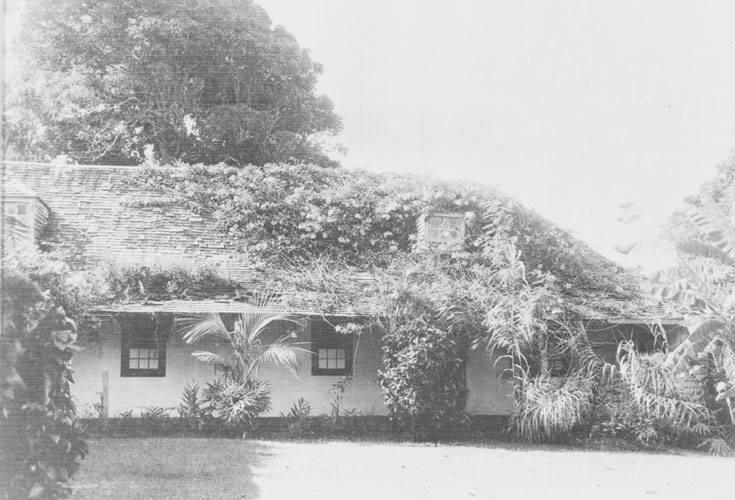In 1819, Kalanimōkū was the first Hawaiian Chief to be formally baptized a Catholic, aboard the French ship Uranie.
“The captain and the clergyman asked Young what Ka-lani-moku’s rank was, and upon being told that he was the chief counselor (kuhina nui) and a wise, kind, and careful man, they baptized him into the Catholic Church” (Kamakau). Shortly thereafter, Boki, Kalanimoku’s brother (and Governor of Oʻahu) was baptized.
It wasn’t until July 7, 1827, however, that the pioneer French Catholic mission arrived in Honolulu. It consisted of three priests of the Order of the Sacred Hearts of Jesus and Mary; Father Alexis Bachelot, Abraham Armand and Patrick Short. They were supported by a half dozen other Frenchmen.
The Congregation of the Sacred Hearts of Jesus and Mary and of the Perpetual Adoration of the Most Holy Sacrament of the Altar is a Roman Catholic religious institute of brothers, priests and nuns. (The letters following their names, SS.CC., are the Latin initials for Sacrorum Cordium, “of the Sacred Hearts”.)
Their first mass was celebrated a week later on Bastille Day, July 14, and a baptism was given on November 30, to a child of Don Francisco de Paula Marin.
The American Congregationalists encouraged a policy preventing the establishment of a Catholic presence in Hawaiʻi. Catholic priests were forcibly expelled from the Islands in 1831.
In 1837, two other Catholic priests arrived. However the Hawaiian government forced them back onto a ship. American, British and French officials in Hawaii intervened and persuaded the king to allow the priests to return to shore.
One of the priests expelled in 1837 was Rev. Louis Désiré Maigret. Born September 14, 1804 in Maille, France, at the age of 24, Maigret was ordained to the priesthood as a member of the Congregation of the Sacred Hearts of Jesus and Mary on September 23, 1828.
“Governor Kekūanāoʻa, in charge of harbor traffic and of immigration, questions the new arrivals. The English consul vouches for Columban Murphy, and he is allowed to land.”
“Maigret, however, must stay on board and is to sail away at the first opportunity. And, together with Maigret, Kekūanāoʻa plans to get rid of another undesirable, the patient Father Bachelot, who, as it happens, is not only a priest but a very sick man.” (Charlot)
On June 17, 1839, King Kamehameha III issued the Edict of Toleration permitting religious freedom for Catholics.
Maigret sailed to Pohnpei in Micronesia to set up a mission there; he was the first missionary they had seen. He later departed for Valparaiso (Chile.)
However, when the Vicar Apostolic of Oriental Oceania was lost at sea, Father Maigret was appointed the first Vicar Apostolic of the Sandwich Islands (now the Roman Catholic Diocese of Honolulu.) They sought to expand the Catholic presence.
At the end of the year 1840, Maigret jots down this balance sheet: Vicariate of Oceania: Catholics: 3,000; Heretics: 30,000 and Unbelievers: 100,000. (Charlot)
Maigret oversaw the construction of what would become his most lasting legacy, the Cathedral of Our Lady of Peace, still standing and in use in downtown Honolulu.
Maigret was officially ordained as a Bishop on November 28, 1847.
Maigret divided Oʻahu into missionary districts. Shortly after, the Windward coast of Oʻahu was dotted with chapels. The Sacred Hearts Father’s College of Ahuimanu was founded by the Catholic mission on the Windward side of Oʻahu in 1846.
“Outside the city, at Ahuimanu, Maigret has now a country retreat that he refers to by the Hawaiian word māla. It is a combination garden, orchard and kitchen garden. Nuhou describes it, “The venerable bishop has built his own vineyard and planted his own orchard …”
“His retreat in the mountain, his ‘garden in the air’ as he terms it, is a pleasant and profitable sight … with a small stone-walled cottage about fifteen feet by ten.” When the pressure of events allows it, Maigret takes refuge there.” (Charlot)
Although the College of Ahuimanu flourished, as apparently reported by the Bishop in 1865, “The college and the schools are doing well. But as the number of pupils is continually on the increase, it has become necessary to enlarge the college. First we have added a story and a top floor with an attic; then we have been obliged to construct a new building. And yet we are lacking room.”
One of its students, Damien (born as Jozef de Veuster,) arrived in Hawaiʻi on March 9, 1864, at the time a 24-year-old choirboy. Determined to become a priest, he had the remainder of the schooling at the College of Ahuimanu.
Bishop Maigret ordained Father Damien de Veuster at the Cathedral of Our Lady of Peace, on May 21, 1864; in 1873, Maigret assigned him to Molokaʻi. Damien spent the rest of his life in Hawaiʻi. In 2009, Father Damien was canonized by Pope Benedict XVI.
The College of Ahuimanu changed locations and also changed its name a couple of times. In 1881, it was renamed “College of St. Louis” in honor of Bishop Maigret’s patron Saint, Louis IX. It was the forerunner for Chaminade College and St Louis High School.
Bishop Maigret died on June 11, 1882, after 42 years of service in Hawaiʻi, 35 of those years as a Bishop. He is buried in a crypt below the Cathedral of Our Lady of Peace.






















